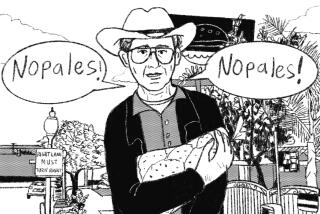Editor of Southland-based magazine wants to share immigrants’ stories

At a recent cocktail mixer for minority business owners at a hotel in Santa Ana, all action seemed to swirl around Pamela Anchang.
Striking in a gray floral dress and a chunky beaded necklace from Cameroon, the Central African nation she came from 20 years ago, Anchang exchanged warm greetings with Radi Miranda, an Orange County insurance salesman who was born in the Philippines, and Sanja Dalal, a tech chief executive born in India. She embraced Mohammed Islam, an accountant from Bangladesh, and kissed the cheek of Kim Yen Huynh, a retired banker from Vietnam.
------------
FOR THE RECORD:
Immigrant Magazine: An article in the Oct. 20 LATExtra section about the Immigrant Magazine website misspelled tech executive Sanjay Dalal’s first name as Sanja.
------------
As editor of The Immigrant Magazine, a Southern California-based news and features website that bills itself as “the voice of immigrants in America,” Anchang has made friends across the diverse spectrum of immigrant communities in the Los Angeles area.
Her goal is to tell the unfiltered stories of those who came here from afar, and to interpret their shared experience.
On any given day Anchang might be found at a Polish film festival, a Cinco de Mayo party or a traditional Hindu celebration at an Indian temple in Norwalk. She might be working from her home office in Rancho Cucamonga, writing about influential immigrants such as the Persian American mayor of Beverly Hills or filming an interview with a French actress or a Nigerian gospel singer for her new Web series.
Anchang and her husband, Charles, started the project as a print magazine in 2004 because they saw a gap in how immigrants to the United States were portrayed by the dominant media outlets.
“I did not feel represented,” Anchang said. “All the stories about immigrants were about illegal immigration and how immigrants were a drain on the economy.”
So she decided to do something different: Tell positive stories about immigrants succeeding in America. “My mission is to uplift,” she said.
The publication, which Anchang produces with the help of several freelance writers, survives on advertising from companies trying to reach an immigrant audience. A weekly newsletter of the site’s top stories is distributed by email.
Vladek Juszkiewicz, the director of that Polish Film Festival, which Anchang recently featured on the website, said she and the site help “build bridges” between immigrants from various backgrounds by showing what they have in common.
“It doesn’t matter if you’re coming from Europe or Africa or Asia, we all deal with the same problems,” he said. “It’s difficult, period. It’s difficult dealing with separation from the families and the culture and the language.”
The sprawling suburbs of Rancho Cucamonga are a far cry from the grasslands of northwest Cameroon, where Anchang grew up.
She was studying to be a teacher when she decided to leave Cameroon in 1994. Her cousin, opposition leader John Fru Ndi, had recently mounted a strong challenge to President Paul Biya, who has led the country since 1982, and Anchang said she feared reprisals.
She applied for and won political asylum in the U.S. But her early years here were not easy.
After working as a desk clerk at a condominium in Washington, D.C., Anchang got a job at a middle school teaching mostly African American students. She said they bullied her, making fun of her accent and asking if all Africans lived in trees.
“The kids couldn’t relate to me,” she said.
When she met another Cameroonian immigrant who was living in California, she followed him.
She found a more accepting climate in Los Angeles, and she soon found herself drawn to immigrants from other countries. They were everywhere: at the bus stop, at the international markets where she shopped, in the break rooms at several companies where she worked as a network engineer after earning a degree in computer engineering.
She said she feels “a kind of camaraderie” with immigrants from other places. “Even though we don’t look the same, we have a shared experience,” she said.
She decided to start the magazine to capture that shared experience. Most established immigrant communities in Los Angeles had their own publications, but she wanted to make something that would be interesting to everybody. She wrote her first articles based on responses to an email she sent to friends asking for “immigrant success stories.” A couple of years ago, the publication moved from print to online-only.
In recent years, it has adopted a more political tone as Anchang uses it as a platform to call for an overhaul to the country’s immigration laws and a path to citizenship for the millions of immigrants here without permission.
Even though she is a legal resident here, she relates to those who are not, she said.
“We share the same desires, but we’ve just taken different paths,” she said.
Juan Jose Gutierrez, who organized a recent rally for immigration reform at which Anchang spoke, said it was powerful to see a black African speaking out on what has come to be seen as a Latino issue.
“It’s very striking to see someone who is not expected to be part of a political movement,” Gutierrez said. “Everybody noticed Pamela.”
Twitter: @katelinthicum
More to Read
Start your day right
Sign up for Essential California for news, features and recommendations from the L.A. Times and beyond in your inbox six days a week.
You may occasionally receive promotional content from the Los Angeles Times.







